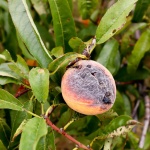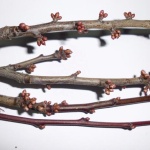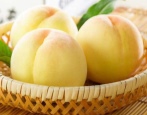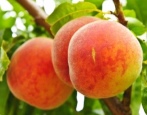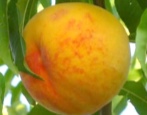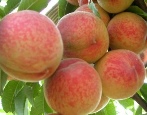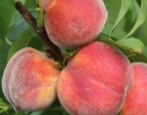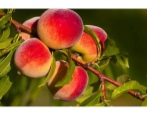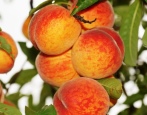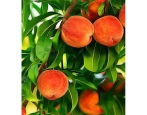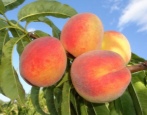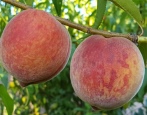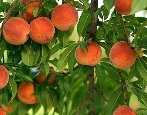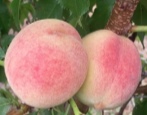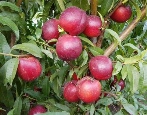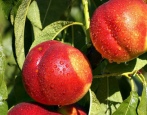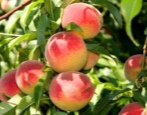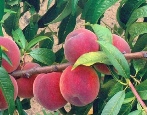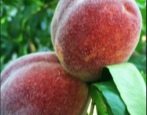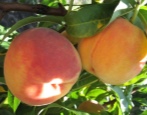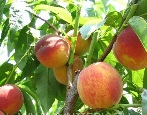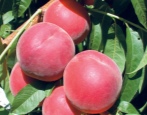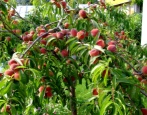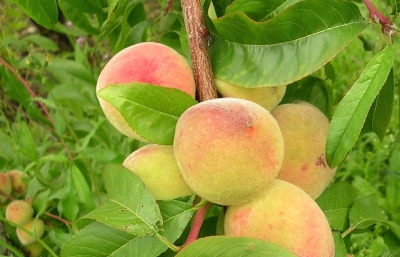
- Growth type: undersized
- Ripening period: mid-season
- Self-fertility: self-fertile
- Appointment: for fresh consumption
- Early maturity: in the second year after planting
- Growing regions: Moscow, Leningrad, Samara region
- Winter hardiness: high
- Disease and pest resistance: practically unaffected
- Fruit weight, g: 90-120
- Fruit color: yellowish green with a bright blush
The common truth - peach, this southern plant - has ceased to be an axiom thanks to the efforts of breeders. Now residents of regions with more severe climatic conditions can grow the cherished fruit. The non-fat variety of Voronezh bush peach is grown both on personal plots and on large farms, which is due to some properties of the plant. The fruits are intended for fresh consumption, for the preparation of winter compotes, jam and other preparations.
Breeding history
The variety appeared as a result of the efforts of amateur gardeners who planted the peach brunion on the cherry plum. The result of many years of work was the Voronezh bush with peach flavor and high frost resistance.
Description of the variety
Low-growing bushy trees, no more than two meters, consist of a flexible central trunk, covered with dark brown bark, and thinner fruit shoots of the same color. The tree is covered with light green oblong foliage, the edges of which are dotted with small teeth. It blooms with large, delicate pink flowers, each of which forms an ovary attached to a strong stalk.
Fruit characteristics
Large rounded (90-120 g) fruits are yellowish-green with a bright blush covering most of the surface. Fruits can easily be transported over an impressive distance, and early maturity is one of the motivating factors for the industrial cultivation of the Voronezh bush. The fruits are covered with a dense, strongly pubescent skin, which does not allow the fruits to crack even in an overripe state. The genetic heritage of the bruignon does not allow the bone to be separated from the pulp. The duration of storage in the refrigerator is one week, while the taste, density, juiciness, color are fully preserved.
Taste qualities
The dark yellow, porous but juicy pulp has a fleshy consistency and a sweet dessert taste and pleasant aroma.
Ripening and fruiting
The variety belongs to the mid-season category - the crop is harvested in mid or late September, depending on the area of cultivation. Fruiting occurs in the second year after planting.
Yield
The variety belongs to high-yielding varieties - up to 30 kilograms of tasty and healthy fruits can be harvested from one adult bush.
Growing regions
Voronezh bush peach is adapted for cultivation in the Moscow, Leningrad and Samara regions, as well as in regions such as the Urals, the Far East and Siberia.
Self-fertility and the need for pollinators
The self-fertility of a peach with bisexual flowers makes it possible to do without additional cultivation of pollinating varieties.
Growing and care
For planting the Voronezh bush peach, sunny areas are chosen, preferably on the southern slopes, with protection from drafts and northern winds. It should be borne in mind that the tree will not be able to fully develop and bear fruit in the shade of a large tree.Its crown will serve as an obstacle to lighting. Seedlings can be planted both in spring and autumn, it all depends on climatic conditions. In the central regions, the autumn option implies planting a peach in the first decade of October. In more northern regions, it is better to postpone the procedure to spring, so that the young plant has time to go through the acclimatization period, take root, get stronger and gain strength before the harsh winter.
The best option for the soil composition is loam with good air permeability, medium acidity, or even slightly acidic soils. Increased acidity must be neutralized by adding dolomite flour, lime fluff, chalk or gypsum. Even wood ash can lower the acid-base balance. Another feature of the tree is a bad reaction to soil with a high potassium content, which negatively affects the development of the peach. If the soil is heavy, then it is necessary to make it a rule to sow under the tree and near it, various siderates. They not only loosen the earth, but also fill it with nitrogen and many other useful substances, and also qualitatively improve its structure. These include phacelia, mustard and others.
The best choice of planting material for the Voronezh bush peach is plants with a closed root system and varietal stock, which can be purchased in specialized stores or nurseries. The optimal size of the planting pit is 50x50x50 cm. At the bottom, drainage must be arranged so that excess moisture does not stagnate and cause putrefactive processes. To do this, use gravel or crushed stone, broken brick or pebbles. The excavated soil is turned into a substrate enriched with organic matter, wood ash, complex mineral fertilizers or superphosphate with the addition of river sand. Part of the resulting mixture is poured into a pit, a seedling is installed and covered with the remaining soil, compacting and abundantly watering with 15-20 liters of warm water. After that, the plant is shortened, leaving 25 cm. Further care consists in certain measures.
Watering is carried out every 3-4 days before flowering, then the frequency of irrigation is reduced to once a week. At the same time, one must remember about the bad reaction of the bush peach to constant waterlogging - if rainy weather is established, then the culture has enough natural precipitation. Top dressing is carried out several times per season. The first introduction of nutrients occurs in early spring before flowering, when the variety needs nitrogen to gain vegetative mass. During flowering, a second feeding is carried out with a solution of potassium sulfate.
The first pruning is done, as mentioned above, immediately after planting. Then, during the annual sanitary pruning in early spring, damaged, deformed, dried or frozen shoots are removed. The formation of the crown implies the thinning of the shoots. The peach bears fruit on the branches of the previous year and on the bouquet branches for two seasons. As a rule, 3-4 of the most powerful shoots are left on the tree, and all sorts of unnecessary branches, extra branches, young branches thickening the bush must be removed.
To help the peach overwinter, the soil under the shrub is covered with a thick layer of humus or compost, the branches of the plant are flexible, they are bent to the ground and fixed, then the entire structure is covered with spruce branches and agrofibre. A special mesh will help from rodents, which is wrapped around the lower part of the plant, slightly deepening the lower edge.
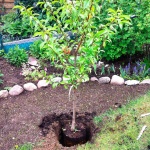
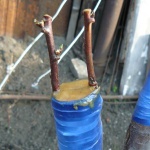
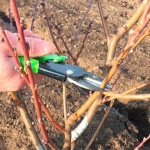
Frost resistance and the need for shelter
The plant has high winter hardiness and easily tolerates negative winter temperatures down to -35ºC. Sometimes freezing of the ground and freezing of the roots occurs, however, high vitality allows the plant to fully recover in one season. In order to prevent death, the bush is covered for the winter.
Disease and pest resistance
The plant has a strong immunity, is almost not affected by pests and is highly resistant to various diseases typical of fruit and berry bushes. However, if the shrub is surrounded by high humidity for a long time, it can cause aphids to appear. Preventive treatments with insecticides and fungicides will help to avoid various troubles.
